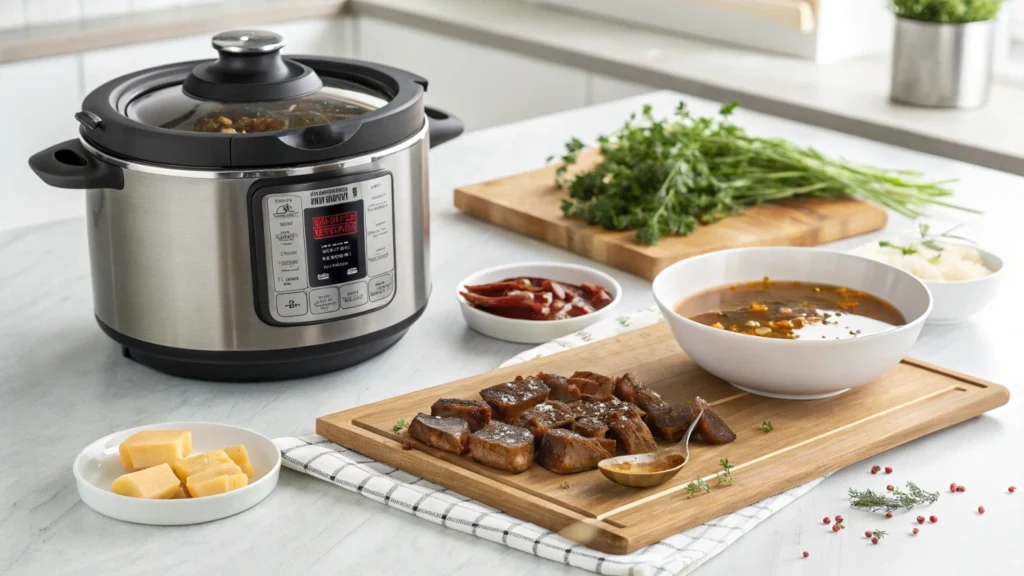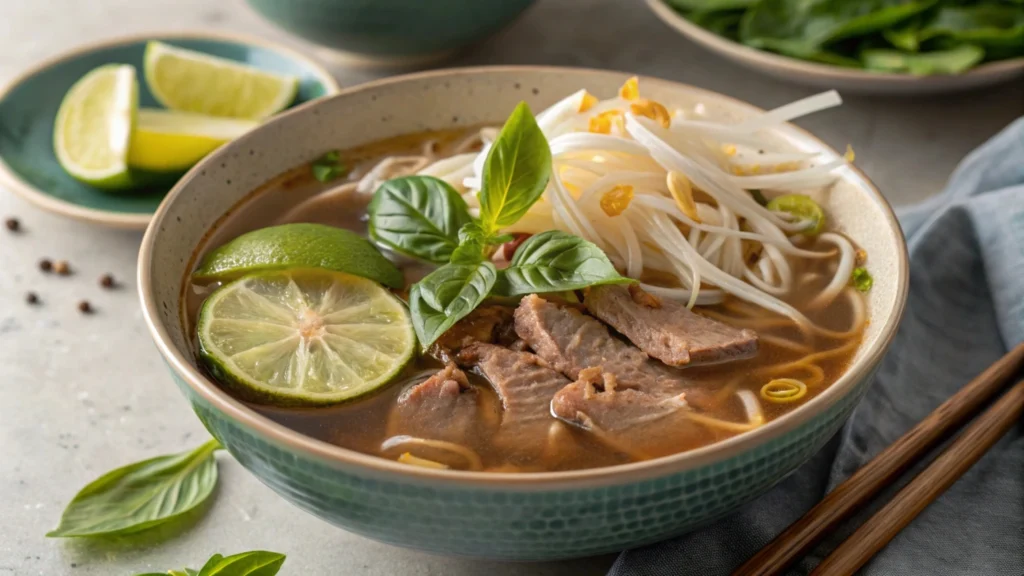Beef tendon might not be the first thing you think of when planning a meal, but this underrated ingredient has been cherished in cuisines worldwide for centuries. Known for its collagen-rich goodness and unique texture, beef tendon is a staple in many Asian dishes, from hearty soups to flavorful stir-fries. In this article, we’ll explore everything you need to know about preparing and cooking beef tendon, share top-notch recipes, and answer frequently asked questions about this culinary gem.
Understanding Beef Tendon
What is Beef Tendon?
Beef tendon is the connective tissue found in cattle, primarily located between muscles and bones. While it might sound like a tough cut, when cooked properly, beef tendon transforms into a gelatinous delight with a melt-in-your-mouth texture.
This ingredient is prized in many cuisines, especially in East Asia, where it’s featured in dishes like Chinese braised beef tendon and Vietnamese pho. Beyond its culinary appeal, it’s valued for its nutritional benefits and versatility in the kitchen.
Nutritional Value and Health Benefits
One of the reasons beef tendon is gaining popularity is its impressive nutritional profile. It’s rich in collagen, a protein known for promoting skin elasticity, joint health, and overall vitality. A typical serving of beef tendon provides:
- High protein content: Supports muscle repair and growth.
- Low fat: A healthier option compared to other cuts.
- Collagen and elastin: Beneficial for skin, hair, and nails.
Consuming beef tendon isn’t just a treat for your taste buds; it’s a way to incorporate nutrient-dense, low-carb food into your diet. Additionally, its gelatinous texture, when cooked, makes it a favorite in comfort dishes.
Preparing Beef Tendon for Cooking
Cooking beef tendon might seem intimidating at first, but a little preparation goes a long way in making it a versatile and delicious ingredient. Follow these steps to get it kitchen-ready for your favorite recipes.
Cleaning and Trimming the Tendon
The first step in preparing beef tendon is to ensure it’s clean and free of impurities. Here’s how to do it:
- Rinse thoroughly: Run the tendon under cold water to remove any surface debris.
- Trim excess fat: Use a sharp knife to cut away visible fat and sinew, which can affect the texture during cooking.
- Blanching for cleanliness: Bring a pot of water to a boil, then blanch the tendon for 5-7 minutes. This helps eliminate impurities and ensures a cleaner taste.
Pre-Cooking Methods
To enhance the flavor and texture of your beef tendon recipe, consider these pre-cooking methods:
- Marination: Soak the tendon in a mixture of soy sauce, ginger, and garlic for a few hours or overnight. This imparts a depth of flavor to the dish.
- Freezing tip: If you plan to slice the tendon thinly, partially freezing it makes cutting much easier.
By following these steps, you set the stage for creating tender and flavorful beef tendon dishes that are perfect for soups, stir-fries, or braised recipes.
Cooking Methods for Beef Tendon
Transforming beef tendon into a melt-in-your-mouth delight requires patience and the right technique. Here are some tried-and-true methods to achieve the perfect texture and flavor.

Slow Cooking Techniques
Slow cooking is one of the best ways to prepare beef tendon, as it allows the tissue to break down gradually, resulting in a tender and gelatinous texture.
- Braising: Combine the tendon with soy sauce, star anise, and beef broth in a heavy pot. Simmer for 2-3 hours until tender.
- Stewing: Add vegetables like carrots, potatoes, and onions to the pot for a hearty, complete meal.
This method is ideal for dishes like Chinese braised beef tendon or traditional beef tendon stew.
Pressure Cooking for Speed
If you’re short on time, a pressure cooker is a lifesaver for tenderizing beef tendon quickly:
- Cooking time: In a pressure cooker, beef tendon typically takes about 40-50 minutes to reach the desired tenderness.
- Flavor tips: Use aromatic spices such as cinnamon, garlic, and peppercorns to infuse the tendon with bold flavors.
Innovative and Modern Cooking Approaches
For those who enjoy experimenting, modern cooking techniques can elevate your beef tendon recipe:
- Sous Vide Method: Cook the tendon at a low temperature (around 176°F or 80°C) for 12-16 hours. This locks in moisture and ensures a consistent texture.
- Fusion dishes: Incorporate cooked tendon into trendy dishes like tacos, salads, or even pasta for a unique twist.
Each method highlights the versatility of beef tendon, making it an adaptable ingredient for various cuisines. Whether you prefer traditional stews or modern culinary creations, these techniques ensure your dish is a hit.
For more tips on slow-cooking meats, you might enjoy Black Pepper Beef: The Ultimate Guide, a recipe-focused guide with helpful cooking insights.
Top 5 Beef Tendon Recipes to Try
Beef tendon is a versatile ingredient that shines in a variety of dishes. From classic Asian soups to modern fusion delights, here are five standout beef tendon recipes that you’ll love.

Traditional Chinese Braised Beef Tendon
This dish is a hallmark of Chinese cuisine, known for its rich flavors and tender texture.
- Ingredients: Soy sauce, star anise, ginger, garlic, and a splash of rice wine.
- Instructions: Simmer the tendon with the listed ingredients for 2-3 hours until it becomes soft and gelatinous.
- Serving Tip: Pair it with steamed rice or noodles for a complete meal.
Beef Tendon Pho
A beef tendon recipe wouldn’t be complete without this Vietnamese classic. The tendon adds a silky, chewy texture to the aromatic pho broth.
- Ingredients: Beef tendon, rice noodles, star anise, cinnamon, and fresh herbs like cilantro and basil.
- Instructions: Slow-cook the tendon with the broth ingredients for several hours, then serve over rice noodles with garnishes.
- Pro Tip: Add a splash of fish sauce for authentic flavor.
Spicy Tendon Stir-Fry
For a bold and flavorful twist, try stir-frying beef tendon with spicy seasonings.
- Ingredients: Cooked beef tendon, chili paste, garlic, and sesame oil.
- Instructions: Sauté the tendon with the seasonings until heated through. Add vegetables for extra crunch.
- Pairing Idea: Serve with steamed jasmine rice.
Beef Tendon Soup with Vegetables
This comforting soup is perfect for chilly days.
- Ingredients: Beef tendon, carrots, potatoes, celery, and beef stock.
- Instructions: Simmer the ingredients together until the vegetables are tender and the tendon is melt-in-your-mouth soft.
- Pro Tip: Season with thyme and bay leaves for a fragrant touch.
Beef Tendon in Peanut Sauce
This Southeast Asian-inspired dish is creamy, nutty, and utterly delicious.
- Ingredients: Beef tendon, peanut butter, coconut milk, and spices like turmeric and chili.
- Instructions: Cook the tendon in the sauce until well-coated and tender.
- Serving Suggestion: Pair with roti or steamed rice.
For additional recipe inspiration, check out Black Pepper Beef: The Ultimate Guide for more ways to enjoy tender, flavorful cuts of beef.
Tips and Tricks for Perfect Beef Tendon Dishes
Mastering beef tendon recipes requires attention to detail. Here are some expert tips to make your dishes shine.
Common Cooking Mistakes and How to Avoid Them
- Rushing the process: Beef tendon requires slow, gentle cooking to become tender. Avoid high heat to prevent it from becoming rubbery.
- Skipping pre-cooking: Always blanch or clean the tendon before cooking to remove impurities and improve taste.
- Over-seasoning early: Add salt and strong spices toward the end of cooking to prevent overpowering the dish.
Pairing Tendon with Other Ingredients
Beef tendon works beautifully with a variety of flavors and textures:
- Rich broths: Its gelatinous quality enhances soups and stews.
- Crunchy vegetables: Carrots, celery, and snap peas create a delightful contrast.
- Spicy sauces: Tendon absorbs bold flavors like chili paste or curry.
Storing and Reheating Leftover Beef Tendon
Got leftovers? Here’s how to handle them:
- Storage: Keep cooked tendon in an airtight container in the fridge for up to three days.
- Reheating: Simmer gently in broth or sauce to preserve its texture.
- Freezing: Cooked tendon freezes well for up to three months. Thaw overnight in the fridge before reheating.
With these tips, your beef tendon recipes will always turn out tender, flavorful, and satisfying.
FAQs about Beef Tendon
If you’re new to cooking beef tendon or curious about its benefits, this section answers some of the most commonly asked questions about this unique ingredient.
Is Beef Tendon Good to Eat?
Absolutely! Beef tendon is not only delicious but also incredibly nutritious. Its high collagen content supports joint health, improves skin elasticity, and may even promote gut health. Plus, it’s a low-fat, high-protein food, making it a guilt-free addition to your diet.
What is a Beef Tendon?
A beef tendon is the connective tissue that links muscle to bone in cattle. While it’s firm and tough in its raw state, slow cooking transforms it into a gelatinous, melt-in-your-mouth delight. It’s a key ingredient in many traditional dishes, such as pho and braised tendon stews.
Is Beef Tendon Tasty?
Yes, when prepared correctly, beef tendon is both flavorful and satisfying. Its taste is subtle, often absorbing the flavors of the broth or sauce it’s cooked in. The texture is unique soft, slightly chewy, and incredibly rich making it a standout ingredient in dishes like beef tendon soup or spicy stir-fries.
Is Tendon in Pho Good?
Tendon is one of the signature components of Vietnamese pho. Its gelatinous texture pairs beautifully with the rich, aromatic broth and tender noodles. Many pho lovers enjoy its slightly chewy consistency, which contrasts with the other ingredients in the bowl.
For more culinary tips, you might enjoy exploring Beef Cheeks Cooking Tips for insights into preparing other tender and flavorful beef cuts.
Conclusion: Celebrating the Versatility of Beef Tendon
Beef tendon may not be the most conventional ingredient, but its versatility and nutritional benefits make it worth trying. Whether you’re simmering it in a comforting stew, incorporating it into pho, or experimenting with modern dishes like spicy stir-fries, there’s no shortage of ways to enjoy this culinary gem.
From its unique gelatinous texture to its ability to absorb flavors beautifully, beef tendon is a true kitchen treasure. By following the preparation and cooking tips outlined in this guide, you’ll be able to craft beef tendon recipes that are both satisfying and packed with nutrients.
So, don’t hesitate to add beef tendon to your shopping list. Dive into its rich history, experiment with flavors, and enjoy the results it might just become your next favorite ingredient!

